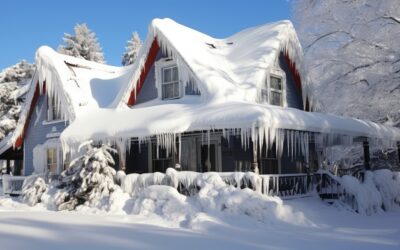How to Remove an Ice Dam
Winter can be a picturesque season, with snow-covered landscapes and frosty trees. However, for homeowners and business owners, it also brings the potential headache of ice dams. Let’s look at what an ice dam is, the damage it can cause to residential and commercial roofs, and how to fix and remove an ice dam from your roof.
What is an Ice Dam?
An ice dam is a ridge of ice that forms along the eaves of a roof or in your gutters, typically during the winter months. It occurs when the heat from your home or business escapes through the roof and melts the snow on the upper part of your roof.
As this melted water flows down the roof, it can refreeze when it reaches the colder eaves, creating a dam of ice. Over time, this dam can grow larger and block the natural drainage of water from the roof.
Damage to Residential Roofs
Ice dams can wreak havoc on residential roofs. The most immediate concern is the added weight they place on your roof. The excess weight of the ice and snow can lead to structural damage, causing sagging or even collapse in extreme cases.
Additionally, as the ice dam blocks the natural flow of water off the roof, it can force water under your shingles or through cracks in the roof, leading to leaks and water damage inside your home. This can result in damaged ceilings, walls, insulation, and even electrical systems.
Moisture trapped beneath the ice dam can also contribute to the growth of mold and mildew, creating an unhealthy indoor environment. This not only poses health risks to residents but also necessitates costly repairs. The aesthetic appeal of your home can also suffer, as water stains on walls and ceilings can be challenging to fix.
Damage to Commercial Roofs
Commercial properties are not immune to the dangers posed by ice dams. In fact, the damage can be even more severe due to the typically larger size of commercial roofs. Similar to residential roofs, the weight of the ice dam can stress the structure, potentially leading to significant damage.
Additionally, water infiltration through the roof can cause floods, damage inventory, equipment, and interior finishes, resulting in costly repairs and business interruptions.
Commercial properties often have flat or low-slope roofs, which are more susceptible to ice dam formation. These roofs tend to accumulate water on the surface, which, when frozen, can exacerbate the problem. The damage caused by ice dams can impact not only the roof but also the overall integrity of the building.
How to Fix an Ice Dam
If you’re faced with an ice dam, it’s essential to address it promptly to prevent further damage. Here are steps you can take if you need to know how to remove an ice dam from your roof:
Safety First
Ensure your safety by using appropriate equipment, such as safety harnesses, and work with a partner if possible.
Remove Snow
Safely remove snow from your roof using a roof rake or a long-handled broom. This will help reduce the source of melting water.
Break the Ice Dam
Gently break the ice dam using a blunt tool or ice melt products specifically designed for roofs. Do not use sharp objects or excessive force, as this can damage your roof.
Clear Gutters and Downspouts
Ensure that your gutters and downspouts are clear of ice and debris to allow for proper drainage.
Insulate and Ventilate
Long-term prevention involves improving your roof’s insulation and ventilation to minimize heat loss.
Professional Help
If the ice dam is extensive or if you’re uncomfortable with the removal process, consider hiring a professional roofing contractor with experience in ice dam removal.
Take Ice Dams Seriously
Ice dams can cause significant damage to both residential and commercial roofs, leading to costly repairs and potential safety hazards. Addressing ice dams promptly is crucial to minimizing these risks. While you can take some steps to remove an ice dam yourself, it’s often best to seek professional help to ensure the job is done safely and effectively.
Call In The Pros
Kingdom Roofing Systems, a full-service commercial and residential roofing contractor in Indiana, is qualified to handle any and all roofing concerns, including ice dams. With our expertise, you can safeguard your property against the damaging effects of ice dams and enjoy peace of mind during the winter months.
Don’t let ice dams compromise the integrity of your roof—reach out to Kingdom Roofing Systems for professional help today.






